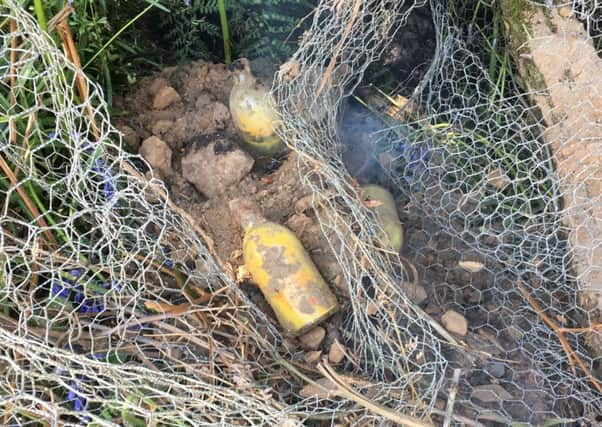Uncovered - Dad’s Army’s lethal message in a bottle


That may be the explanation for the 75-year-old stash of “milk bottles” uncovered by engineers during routine improvement work on the power network.
Wartime ordnance is regularly discovered on the coastline or locations such as the Firth of Clyde - often a German bomb which failed to explode - and the Royal Navy are called in to carry out a safe detonation.
Advertisement
Hide AdAdvertisement
Hide AdHowever this time the emergency was sparked by actions taken by the Home Guard - on land - during the darkest days of the Second World War.
The engineers became concerned when they saw smoke issuing from the yellowing bottles.
SPEN team leader Duncan Muir said: “The lads thought it was old milk at first when they saw the yellowed glass bottles, then one started slowly smoking and that’s when our health and safety training kicked in.
“We covered them back over with soil and retreated to a safe distance to call the fire brigade and the Ministry of Defence.
Advertisement
Hide AdAdvertisement
Hide Ad“The bomb squad were soon on site and knew exactly what to do.
“A 100 metre exclusion zone was put in place, and we played our part in turning off the power supply in the immediate area to allow for a safe controlled explosion to be carried out”.
No harm was done, although three homes were evacuated as a precaution, but if the engineers had been careless the consequences could have been very serious.
The bottles were crude but effective phosphorous grenades, intended to be lobbed at Nazi tanks and other vehicles in the event of an invasion.
Advertisement
Hide AdAdvertisement
Hide AdUnlike the DIY “Molotov cocktail” incendiary used by the Soviets and anti-Nazi partisans when nothing more reliable was available the phosphorous weapons were self-igniting, and were capable of reducing any vehicle, no matter how powerful, to cinders.
Anyone in a vehicle hit by such a weapon was likely to die a terrible death.
The Home Guard hid caches of them all over the country, but it wasn’t always possible to keep records of exactly where.
The danger of invasion receded, then evaporated, and a few months after Operation Overlord on June 6, 1944, the Home Guard were stood down - in this case inadvertently leaving a potent reminder of how war to the finish was to be conducted against the fascists.
Duncan Muir, whose team made the discovery in Dumfries and Galloway, said: “I’ve worked for SP Energy Networks for almost 30 years and have never come across anything like this before”.